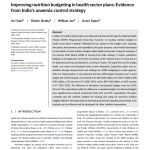
How to improve Judicial Accountability – Resolutions from the RTI convention
8 April 2011
Last month, Accountability Initiative was invited to facilitate a discussion on Judicial Accountability at the RTI convention, held by NCPRI. The topic for brainstorming was “How can RTI be used to promote transparency and accountability in judicial institutions?” The discussion largely centered around the RTI, but a few other pertinent matters were also discussed (see discussion on National Judicial Council Bill below). Following are the resolutions from the meeting.
Section A : Proactive Disclosure
The first centered around voluntary disclosure of information under section4(1) of the RTI act. Presently, the information proactively disclosed by the courts is sparse and inadequate. The following demands were made by the group. It was also noted that disclosure of this information should not be a one-time affair, but rather a regular exercise.
- Indexed list of case numbers along with the case orders should be available in the public domain. Information should be provided of the entire history of a case, including all orders, all applications made in the matter and each date of hearing. A summary of how long a case has been before the court would also be useful . The Delhi High Court has a system in place, where once you type in a case number, it gives you details of how long a case has been before the court and so on. Though it’s not available to the general public, or infact even to all judges, this computerization should be made the norm across all High Courts
- Category-wise pendency of cases in Courts should be made public. Categories can be civil appeals, criminal appeals, election petitions, civil suits etc
- The comparative formula for calculating disposal should be universal across all High-Courts. Right now, in some courts, if a case by 10 petitioners is disposed, it is counted as 10 disposals, while in other courts, it’s considered to be 1 disposal. There are many such inconsistencies, and this is why it is necessary that the formula for calculating disposals should be made universal.
- Expenditure transparency : Courts should declare how their allocated budgets are being used. In addition, names of contractors to whom contracts have been awarded should be made public.
- Administrative structure of the high court – Composition of committees and various sections of the High Court should be available online for anyone to peruse. There was an allegation that a number of courts do not have their sexual harassment committees in place. So it was specifically noted that the names of members constituting the sexual harassment committee should be made public.
- Minutes of meetings of all full court meetings and all administrative committees should be made public
- Numbers and pendency of disciplinary proceedings and orders : Without taking names of individuals, details should be made available about the numbers and pendency of disciplinary proceedings against court staff.
- Basic infrastructural facilities available in a court : Courts provide a number of facilities such as crèche, drinking water, etc. Details such as the timings for which the facilities are available, location of the facilities and procedure by which these facilities can be availed should be available online. Some of facilities specifically mentioned during the session were crèche, drinking water, sanitation, legal assistance, free legal aid (with list of legal aid lawyers and their contact details), filing facilities, facilities to obtain certified copies, approved formats & pro-formas for different registries
- Annual RTI performance report – An annual RTI report with details of numbers of applications received,number of applications pending, number of applications dismissed etc should be made available in the public domain.
- Service conditions and perks of judges – Details of the service conditions and perks of judges should be in the public domain. In addition, details of official travels (both domestic and foreign) of judges, including mode of travel and expenses, should also be available.
- A personnel map of the court – with all appointments of all court staff should be made public. It should contain details of how a particular appointment was made (either through judges’ personal capacity, employment exchange etc) and details of where they are posted.
- High Court calendar, working hours and overtime hours of all employees should be online
- Sanctioned posts and vacancies for all posts – should be made available in real-time
- Reservation for all posts –should be made available
- Legal services authority performance – Expenses, account details, annual accounts and traveling expenses
Section B : National Judicial Council Bill
The second discussion centered around the National Judicial Council bill which seeks to set up a judicial council to inquire into complaints against errant judges. For a detailed discussion of the bill, please check this link. The unanimous opinion was that this bill needs to be opposed. The participants agreed that the bill is an attempt by the executive to dominate and control the judiciary and that it strikes at the very heart of judicial independence and for these reasons, it should not be countenanced.
However, everybody agreed that there is a need to look into the issues raised by the bill pertaining to misconduct by judges and grievance redressal and a mechanism should be set in place for this issue. A larger consultation and a comparative study of other legal jurisdictions is necessary for this purpose.
Section C : Appointment transparency
Since the judiciary is not democratically appointed and doesn’t have transparency and accountability in its functioning, it can only derive legitimacy from a transparent appointment procedure. The groups demanded that the following be made transparent
- The procedure of appointment
- The criteria of appointment for senior advocates
- Information submitted by applicants for appointment to the bench should be made public.
- In addition to above demands for transparency, it was demanded that the provision for CJI’s prior permission for investigation should be deleted
- There was also a demand to repeal Judges (Protection act) 1985 and to review the decision of the Supreme Court in the Judges case.
- There should be an audit of how High Courts implement the RTI rules
- The charges for an application should be uniform and reasonable across all High Courts.
- Applications should not be rejected for not conforming to the format
- Some of the courts (Madras HC) require that the petitioner come in person to testify. This is wrong.
- No verification should be needed
- The penalty clause should be better implemented and should not be lesser than Rs 250.
- Names and addresses of the PIO’s and appellate authority should be easily available. The PIO’s should be well-publicized.
Section D : RTI rules in courts
- There should be an audit of how High Courts implement the RTI rules
- The charges for an application should be uniform and reasonable across all High Courts.
- Applications should not be rejected for not conforming to the format
- Some of the courts (Madras HC) require that the petitioner come in person to testify. This is wrong.
- No verification should be needed
- The penalty clause should be better implemented and should not be lesser than Rs 250.
- Names and addresses of the PIO’s and appellate authority should be easily available. The PIO’s should be well-publicized.





